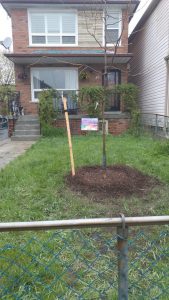
Hello,
I recently bought a home in East York near Woodbine and Mortimer. The south-facing front lawn is currently all grass (but mostly weeds). I would eventually like to replace this with an English-style garden of low-maintenance shrubs, bushes and flowers. This is my first time as a property owner so I have no knowledge of gardening. Which types of plants do you recommend? And what is the best time of year to plant these? Our lawn is full-sun. I am not knowledgeable of the soil quality, but I believe it is fairly good.
Thank you
Congratulations on your new home! A first property is how many gardeners get started. Since there are so many great options for plants in your yard, it would be impossible to list everything in my response, but rather I would like to give you some initial pointers on how to better understand to your garden conditions and how to choose suitable plants.
When selecting plants, it’s important that you choose specimens that will thrive under the conditions you have. The most basic is to determine your climatic conditions or hardiness zone. Since you are in Toronto, then you are likely in Zone 6. You should choose plants that are suitable for Zone 6 or a lower zone to ensure they can withstand winter conditions. You find out more information on hardiness zones here.
You’ve already identified two other important considerations: light and soil. Full-sun means that your yard will receive six or more hours of direct sunlight each day. Note that there can be different areas of your yard that might get less sun because of shade from neighboring buildings or trees, so you may want to observe your yard closely on sunny days and see if there are any spots that may get less sun. I see you have a newly planted tree. It’s difficult to tell the specimen from the photo, but you may also want to consider how fast the tree will grow and whether it will contribute to shade in your garden in the future.
There are a few considerations when assessing the condition of your soil. Soil texture refers to the size and portion of mineral particles, specifically sand, silt and clay. Soil texture is important as it determines drainage and nutrient holding capacity. You can estimate the text of your soil yourself. Here is a link to a simple soil texture analysis test you can do with a few household items.
Another soil consideration is pH or the measure of relative alkalinity or acidity. It’s important to select plants that will thrive under your pH conditions. You may want to consider a home test kits or for more accuracy you can send a sample to a professional lab for testing. Here is a link to certified labs in Ontario ( not always necessary but good to know it exists if your plants are failing). Professional labs will usually also test for nutrient contents (phosphorus, potassium and magnesium) along with the amount of organic material in your soil. If you find deficiencies or challenges in your soil, you have the opportunity to amend your soil when you remove your lawn. Choose a good quality top soil from a reputable nursery or landscaper.
There are two other consideration when choosing plants I would like to note. In smaller city yards, we have the luxury of being able to water our plants whenever we need. You may want to consider plants that require less water to conserve water (and money!). Finally, you may want to consider including native species in your garden. While there are some excellent non-native species as well, adding native species to your garden contributes to the urban ecosystem by providing food and homes for a variety of insects and birds. Whatever your choice, please avoid invasive species that can crowd out native plants. You can find a good list of plants to avoid here.
So armed with information on your climate, light and soil conditions, and with considerations to water requirements and native plants, you can now make effective plant choices for your garden. One great way to get started is take a walk around your neighbourhood and see what you like. Your neighbours likely have similar conditions to yours, so you can see what is thriving. A reputable garden centre can provide advice and guidance if you come with information on your growing conditions and preferences, and of course you can search our site for any number of topics. Lots of information here.
I hope you enjoy your garden for many years to come!

